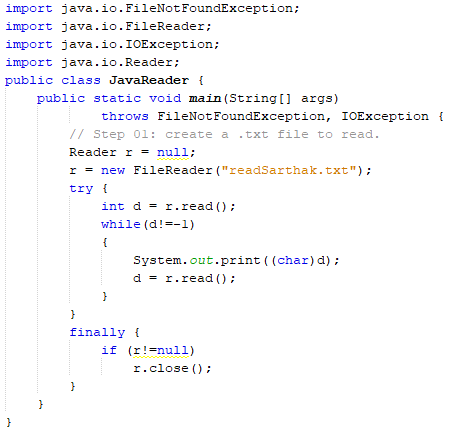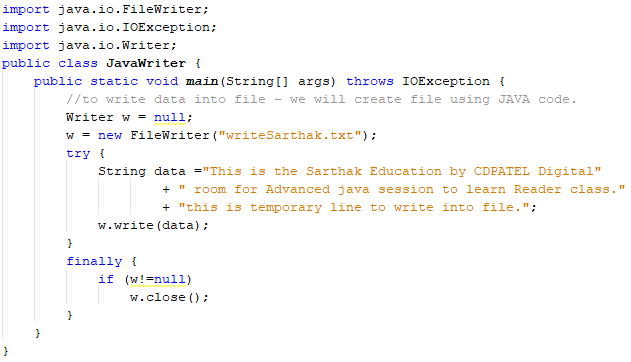Character Streams:
- Byte streams are used to perform input and output of 8-bit bytes
- Character streams are used to perform input and output for 16-bit Unicode.
- All byte stream classes are descended from Reader and Writer.
- Figure:
- There are many Character stream classes.
- When Not to Use Byte Streams?
- When .txt contains character data, the best approach is to use character streams.
- There are also streams for more complicated data types.
- Byte streams should only be used for the most primitive I/O.
- Why talk about byte streams?
- Because all other stream types are built on byte streams.
- Character streams are often "wrappers" for byte streams.
- The character stream uses the byte stream to perform the physical I/O, while the character stream handles translation between characters and bytes.
- For Example:
- FileReader uses FileInputStream, while FileWriter uses FileOutputStream.
- There are two general-purpose byte-to-character "bridge" streams: InputStreamReader and OutputStreamWriter.
- Example: Classes of Reader and Writer stream:
- Syntax:
java.lang.Object
java.io.Reader - Abstract class for reading character streams.
- The only methods that a subclass must implement are read(char[], int, int) and close().
- It has one field, two constructors and seven methods.
- Field:
- protected Object lock
- Constructor:
- protected Reader()
- protected Reader(Object lock)
- Methods:
- 1. close
- Syntax: public abstract void close() throws IOException
- Use: Closes the stream and releases any system resources associated with it.
- Throws: IOException - If an I/O error occurs
- 2. mark
- Syntax: public void mark(int readAheadLimit) throws IOException
- Use: Marks the present position in the stream. Not all character-input streams support the mark() operation.
- Parameters: readAheadLimit - Limit on the number of characters that may be read while still preserving the mark.
- Throws: IOException - If the stream does not support mark(), or if some other I/O error occurs
- 3. markSupported
- Syntax: public boolean markSupported()
- Use: Tells whether this stream supports the mark() operation. The default implementation always returns false. Subclasses should override this method.
- Returns: true if and only if this stream supports the mark operation.
- 4. read
- Syntax:
- public int read() throws IOException
- public int read(char[] cbuf) throws IOException
- public abstract int read(char[] cbuf, int off, int len) throws IOException
- public int read(CharBuffer target) throws IOException
- Use:
- Reads a single character. This method will block until a character is available, an I/O error occurs, or the end of the stream is reached.
- Subclasses that intend to support efficient single-character input should override this method.
- Reads characters into an array.
- Reads characters into a portion of an array.
- Attempts to read characters into the specified character buffer.
- Parameters:
- cbuf - Destination buffer
- off - Offset at which to start storing characters
- len - Maximum number of characters to read
- target - the buffer to read characters into
- Returns:
- The character read, as an integer in the range 0 to 65535 (0x00-0xffff), or -1 if the end of the stream has been reached.
- Throws:
- IOException - if an I/O error occurs
- NullPointerException - if target is null
- ReadOnlyBufferException - if target is a read-only buffer
- 5. ready
- Syntax: public boolean ready() throws IOException
- Use: Tells whether this stream is ready to be read.
- Returns: True if the next read() is guaranteed not to block for input, false otherwise. Note that returning false does not guarantee that the next read will block.
- Throws: IOException - If an I/O error occurs
- 6. reset
- Syntax: public void reset() throws IOException
- Use: Resets the stream. Not all character-input streams support the reset() operation, and some support reset() without supporting mark().
- Throws: IOException - If the stream has not been marked, or if the mark has been invalidated, or if the stream does not support reset(), or if some other I/O error occurs
- 7. skip
- Syntax: public long skip(long n) throws IOException
- Use: Skips characters. This method will block until some characters are available, an I/O error occurs, or the end of the stream is reached.
- Parameters: n - The number of characters to skip
- Returns: The number of characters actually skipped
- Throws:
- IllegalArgumentException - If n is negative.
- IOException - If an I/O error occurs
- Syntax:
java.lang.Object
java.io.Writer - Abstract class for writing to character streams.
- The only methods that a subclass must implement are write(char[], int, int), flush(), and close().
- It has one field, two constructors and four methods.
- Field:
- protected Object lock
- Constructor:
- protected Writer()
- protected Writer(Object lock)
- Methods:
- 1. append
- Syntax:
- public Writer append(char c) throws IOException
- public Writer append(CharSequence csq) throws IOException
- public Writer append(CharSequence csq, int start, int end) throws IOException
- Use:
- Appends the specified character to this writer.
- An invocation of this method of the form out.append(c) behaves in exactly the same way as the invocation: out.write(c)
- Appends the specified character sequence to this writer.
- An invocation of this method of the form out.append(csq) behaves in exactly the same way as the invocation: out.write(csq.toString())
- Appends a subsequence of the specified character sequence to this writer.
- An invocation of this method of the form out.append(csq, start, end) when csq is not null behaves in exactly the same way as the invocation: out.write(csq.subSequence(start, end).toString())
- Parameters:
- c - The 16-bit character to append
- csq - The character sequence to append. If csq is null, then the four characters "null" are appended to this writer.
- start - The index of the first character in the subsequence
- end - The index of the character following the last character in the subsequence
- Returns:
- This writer
- Throws:
- IOException - If an I/O error occurs
- IndexOutOfBoundsException - If start or end are negative, start is greater than end, or end is greater than csq.length()
- 2. close
- Syntax: public abstract void close() throws IOException
- Use: Closes the stream, flushing it first.
- Throws: IOException - If an I/O error occurs
- 3. flush
- Syntax: public abstract void flush() throws IOException
- Use: Flushes the stream.
- Throws: IOException - If an I/O error occurs
- 4. write
- Syntax:
- public void write(char[] cbuf) throws IOException
- public abstract void write(char[] cbuf, int off, int len) throws IOException
- public void write(int c) throws IOException
- public void write(String str) throws IOException
- public void write(String str, int off, int len) throws IOException
- Use:
- Writes an array of characters.
- Writes a portion of an array of characters.
- Writes a single character. The character to be written is contained in the 16 low-order bits of the given integer value; the 16 high-order bits are ignored.
- Writes a string.
- Writes a portion of a string.
- Parameters:
- cbuf - Array of characters to be written
- off - Offset from which to start writing characters
- len - Number of characters to write
- c - int specifying a character to be written
- str - String to be written
- Throws:
- IndexOutOfBoundsException - If off is negative, or len is negative, or off+len is negative or greater than the length of the given string
- IOException - If an I/O error occurs.
Example (Read File):
- Step 01: Create a .txt file.
- Step 02: Write a JAVA program.
- Step 03: Enjoy the Output.
Example (Write File):
- Step 01: Write a JAVA program.
- Step 02: Enjoy the Output.
- Step 03: Read data from File, also.
Tags:
Java








